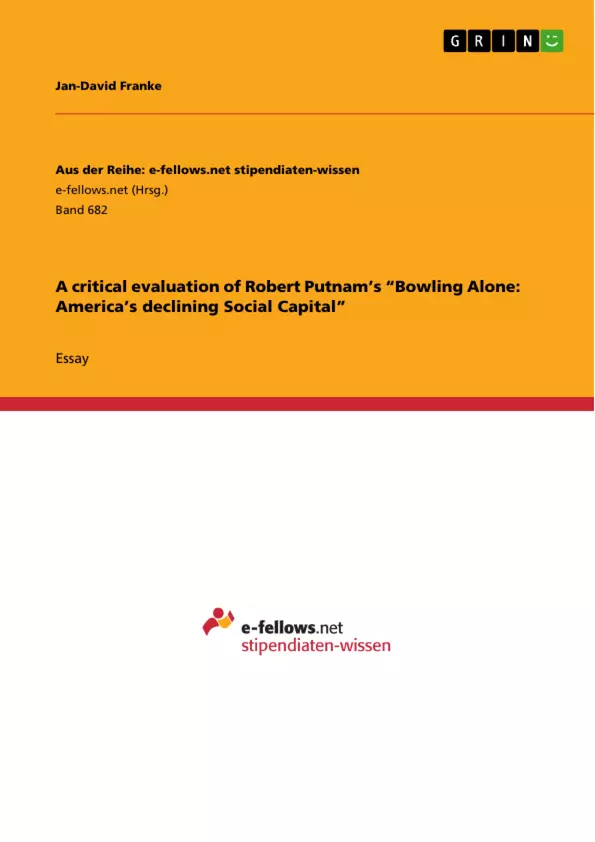This paper critically evaluates Robert Putnam’s “Bowling Alone: America’s declining social capital”, published in 1995 in the Journal of Democracy, both empirically and theoretically. It counterchecks the empirical findings by Putnam based on data from the WorldValuesSurvey of 2006 and thereby also provides an updated view on Putnam's claim of declining social capital in the United States. Subsequentially Putnam's theory is put into contrast with and linked to works by Granovetter (1973), Dalton (2008); Fischer (2001); Fischer & Hout (2006); Stolle, Hooghe & Micheletti (2005); Kadushin (2004).
Table of Contents
- A critical evaluation
- Empirical evaluation
- Theoretical remarks
- Conclusion
Objectives and Key Themes
This paper provides a critical evaluation of Robert Putnam’s "Bowling Alone: America's Declining Social Capital," analyzing both the empirical and theoretical claims. The paper focuses on the United States and examines the validity of Putnam's arguments using data from the World Values Survey (WVS).- The decline of social capital in the United States since the 1960s
- The relationship between civic engagement and social capital
- Putnam's proposed explanations for the decline in social capital
- The role of interpersonal trust in social capital
- The validity of Putnam's findings in light of recent WVS data
Chapter Summaries
A critical evaluation
This chapter introduces the paper's objective: to critically evaluate Robert Putnam's "Bowling Alone." It outlines the methodology, which includes comparing Putnam's findings with matching indicators from the World Values Survey (WVS) to provide an updated perspective on his analysis. The chapter also presents Putnam's argument about the decline of American social capital since the 1960s and his proposed explanations for this trend, including the growing employment of women, increasing residential mobility, demographic shifts, and technological individualization of leisure.Empirical evaluation
This chapter focuses on analyzing specific indicators of social capital, such as political participation, civic engagement, religious affiliation, and interpersonal trust, using data from the WVS. It compares Putnam's observations with the WVS data, revealing discrepancies in some areas, such as voter turnout and the decline of religious affiliation. The chapter also discusses the limitations of the WVS data and the potential influence of other factors on the observed trends.Theoretical remarks
This chapter critically evaluates Putnam's theoretical framework, comparing his perspective on social capital with other currents of research. It explores the concept of mobilized social capital and the distinction between network contacts and actual social capital, highlighting Kadushin's critique of Putnam's collectivistic approach.Keywords
This paper explores the complex relationship between social capital, civic engagement, and societal trends in the United States. It examines Putnam's "Bowling Alone" thesis, analyzing the validity of his claims using data from the World Values Survey and exploring theoretical perspectives on social capital. Key concepts include social capital, civic engagement, political participation, religious affiliation, interpersonal trust, and the role of the World Values Survey in assessing societal changes.
Excerpt out of 13 pages
- scroll top
- Quote paper
- Jan-David Franke (Author), 2012, A critical evaluation of Robert Putnam’s “Bowling Alone: America’s declining Social Capital”, Munich, GRIN Verlag, https://www.grin.com/document/210436
Look inside the ebook



